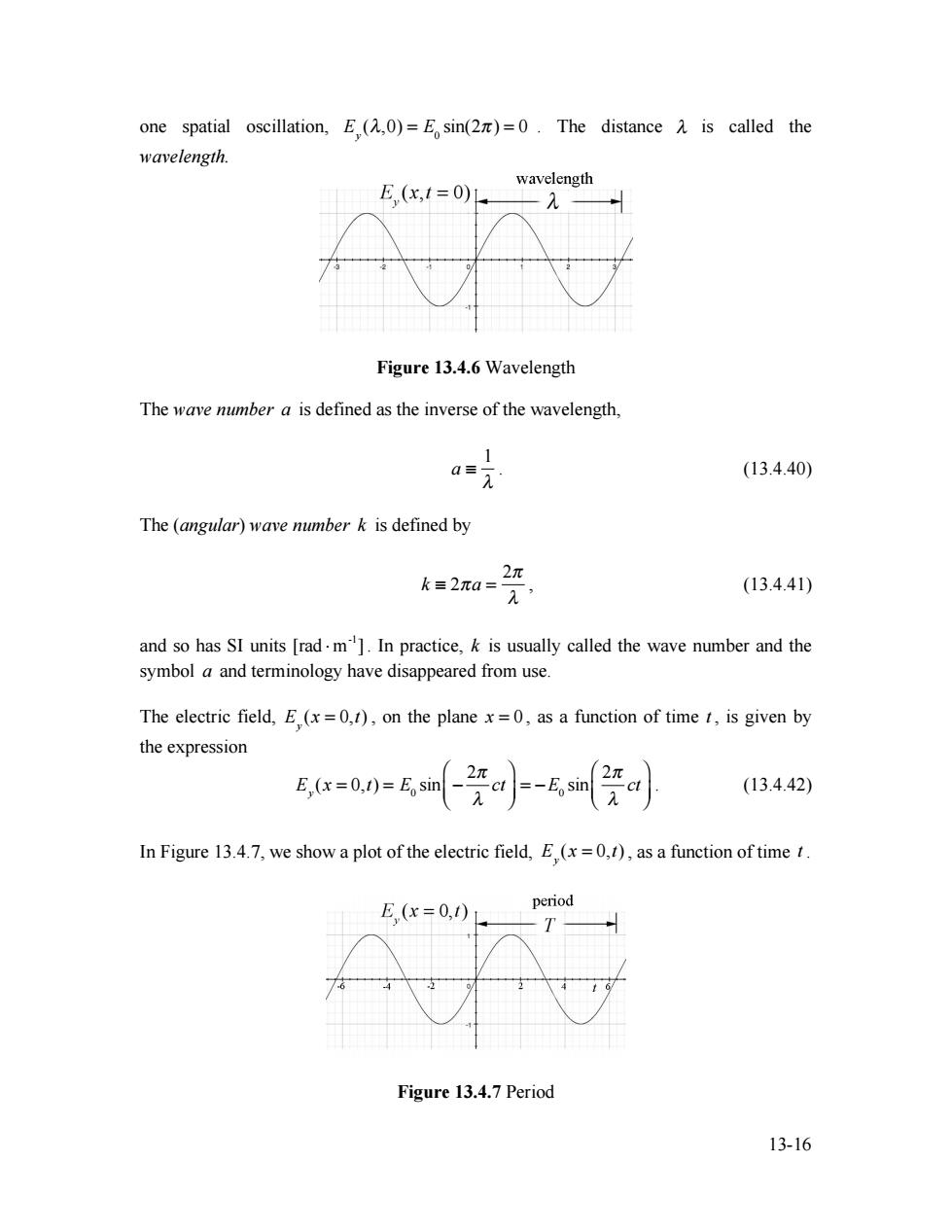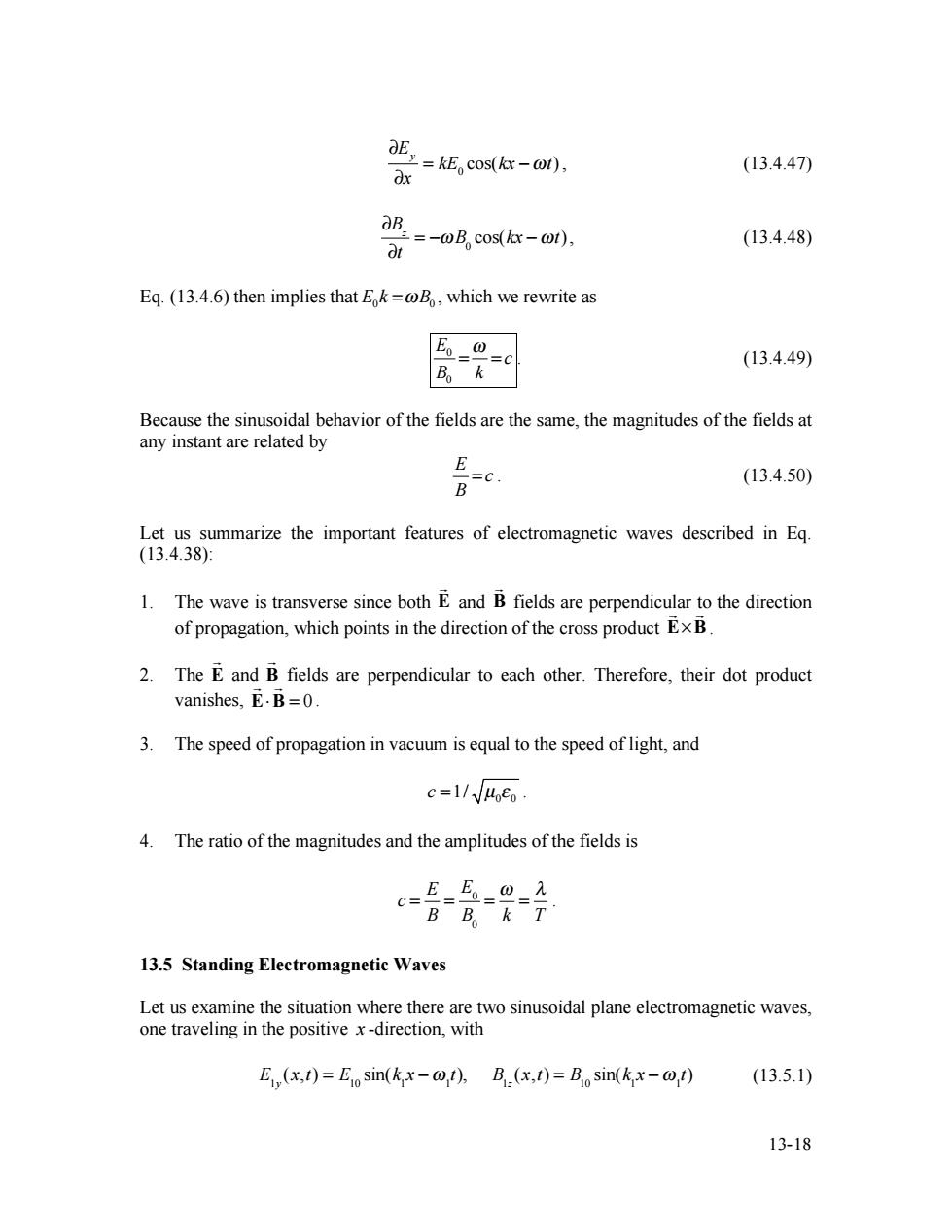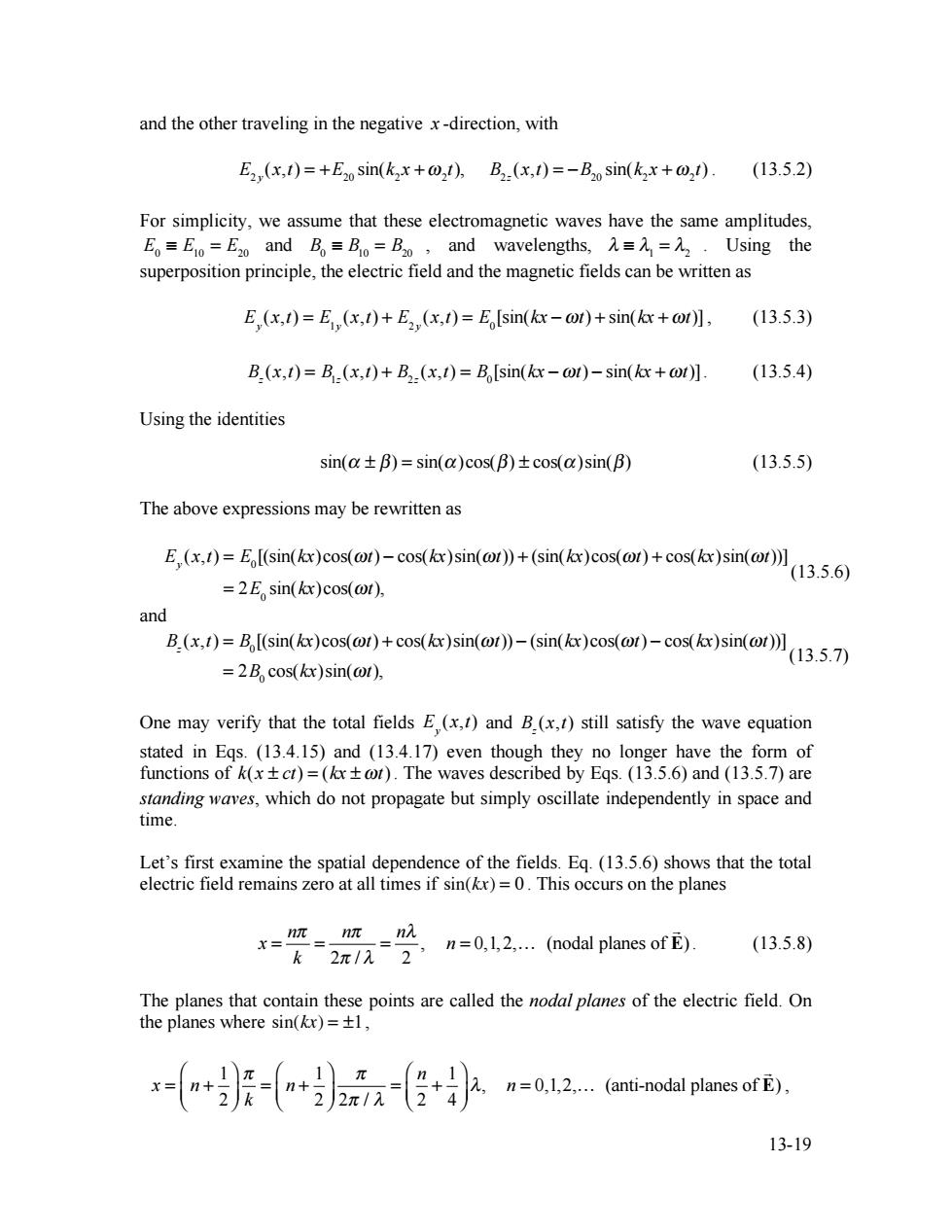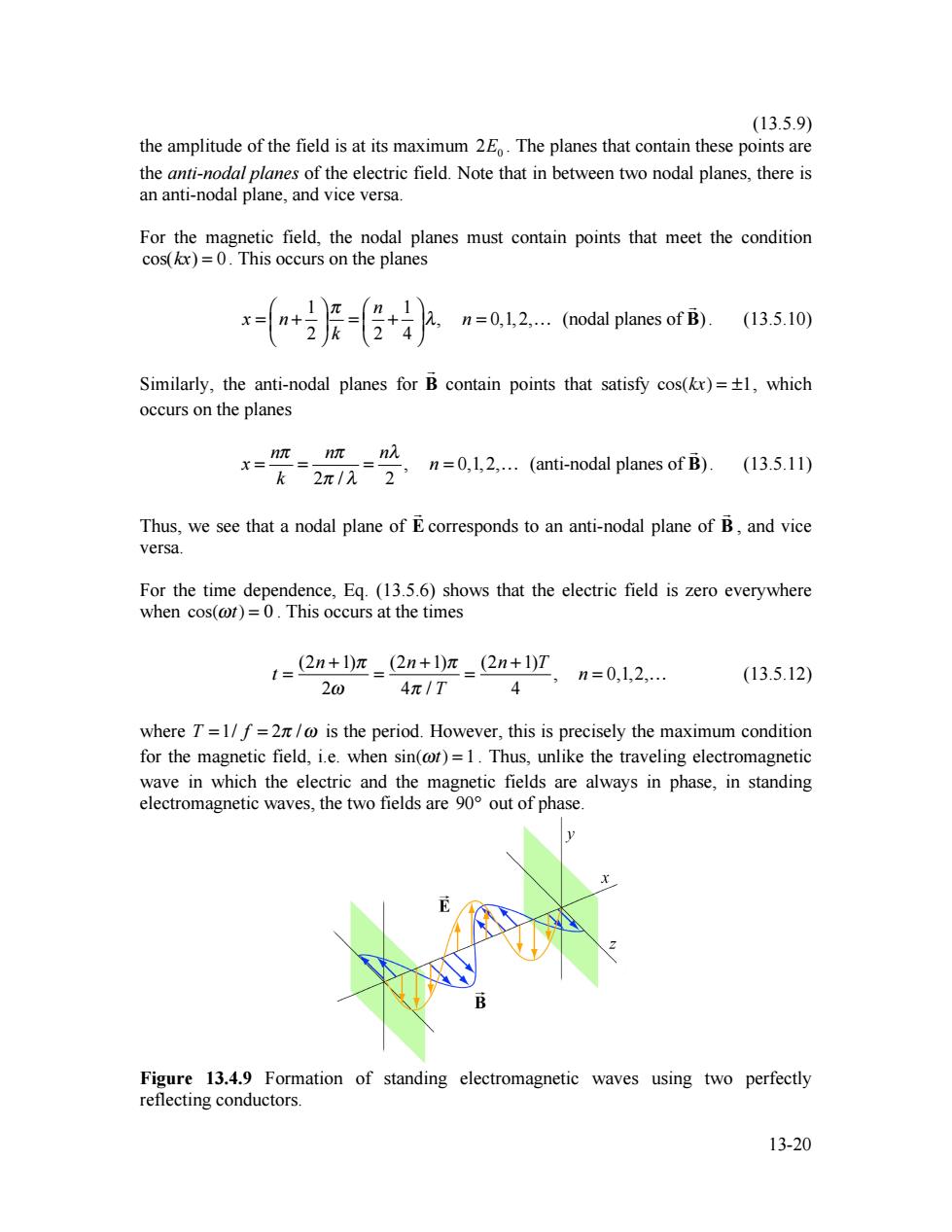
one spatial oscillation,E (A,0)=E sin(2)=0.The distance is called the wavelength. wavelength E(x,t=0) Figure 13.4.6 Wavelength The wave number a is defined as the inverse of the wavelength, 1 (13.4.40) The (angular)wave number k is defined by k≡2πa= 2π (13.4.41) and so has SI units [rad.m].In practice,k is usually called the wave number and the symbol a and terminology have disappeared from use. The electric field,E(x=0,t),on the plane x=0,as a function of time t,is given by the expression ,=00=瓜m受a-m (13.4.42) In Figure 13.4.7,we show a plot of the electric field,E(x=0,t),as a function of time t. E,(x=0,) period T Figure 13.4.7 Period 13-16
13-16 one spatial oscillation, E y (!,0) = E0 sin(2") = 0 . The distance ! is called the wavelength. Figure 13.4.6 Wavelength The wave number a is defined as the inverse of the wavelength, a ! 1 " . (13.4.40) The (angular) wave number k is defined by k ! 2"a = 2" # , (13.4.41) and so has SI units [rad !m-1 ]. In practice, k is usually called the wave number and the symbol a and terminology have disappeared from use. The electric field, E y (x = 0,t) , on the plane x = 0 , as a function of time t , is given by the expression E y (x = 0,t) = E0 sin ! 2" # ct $ % & ' ( ) = !E0 sin 2" # ct $ % & ' ( ) . (13.4.42) In Figure 13.4.7, we show a plot of the electric field, E y (x = 0,t) , as a function of time t . Figure 13.4.7 Period

At time t=0,E(0,0)=0.Let T be the time that it takes the electric field to complete one oscillation on the plane x=0.Then E(0,T)=-E sin(2cT/)=0.This condition is satisfied when 入 T=, (13.4.43) then E (0,T)=-E sin(2)=0.The time T is called the period.The frequency f is defined as the inverse of the period, (13.4.44) The angular frequency o is defined by 2π2πc 0≡2πf= (13.4.45) Tλ The SI units of angular frequency are [rad.s]. With these definitions we can rewrite our electric and magnetic fields as E=E,(x,t)j=Esin(kx-@t)j (13.4.46) B=B.(x,t)k=B.sin(kx-@t)k In empty space,the wave propagates at the speed of light c.The characteristic behavior of the sinusoidal electromagnetic wave is illustrated in Figure 13.4.8. Figure 13.4.8 Plane electromagnetic wave propagating in the +x-direction. We see that the E and B fields are always in phase (attaining maxima and minima at the same time.)To obtain the relationship between the field amplitudes Eo and Bo,we make use of Egs.(13.4.6)and (13.4.12).We first calculate the following the partial derivatives 13-17
13-17 At time t = 0 , E y (0,0) = 0 . Let T be the time that it takes the electric field to complete one oscillation on the plane x = 0 . Then E y (0,T ) = !E0 sin(2"cT / #) = 0 . This condition is satisfied when T = ! c , (13.4.43) then E y (0,T ) = !E0 sin(2") = 0 . The time T is called the period. The frequency f is defined as the inverse of the period, f ! 1 T . (13.4.44) The angular frequency ! is defined by ! " 2# f = 2# T = 2#c $ . (13.4.45) The SI units of angular frequency are [rad !s -1 ]. With these definitions we can rewrite our electric and magnetic fields as ! E = E y (x,t)ˆ j = E0 sin(kx !"t)ˆ j ! B = Bz (x,t)kˆ = B0 sin(kx !"t)kˆ . (13.4.46) In empty space, the wave propagates at the speed of light c . The characteristic behavior of the sinusoidal electromagnetic wave is illustrated in Figure 13.4.8. Figure 13.4.8 Plane electromagnetic wave propagating in the +x- direction. We see that the E ! and B ! fields are always in phase (attaining maxima and minima at the same time.) To obtain the relationship between the field amplitudes E0 and B0 , we make use of Eqs. (13.4.6) and (13.4.12). We first calculate the following the partial derivatives

a证-kE,cos(-o), (13.4.47) O aB.--oB,cos(kx-o). (13.4.48) d Eq.(13.4.6)then implies that Eok=0B,which we rewrite as E-0 =C (13.4.49) Bo k Because the sinusoidal behavior of the fields are the same,the magnitudes of the fields at any instant are related by E =C. (13.4.50) B Let us summarize the important features of electromagnetic waves described in Eq. (13.4.38): 1.The wave is transverse since both E and B fields are perpendicular to the direction of propagation,which points in the direction of the cross product ExB 2.The E and B fields are perpendicular to each other.Therefore,their dot product vanishes,E.B=0. 3.The speed of propagation in vacuum is equal to the speed of light,and c=1/V4e0 4.The ratio of the magnitudes and the amplitudes of the fields is E-E=0=2 C= BB。kT 13.5 Standing Electromagnetic Waves Let us examine the situation where there are two sinusoidal plane electromagnetic waves, one traveling in the positive x-direction,with E(x,t)=Eosin(k x-@t),B.(x,t)=Bosin(kx-@t) (13.5.1) 13-18
13-18 !E y !x = kE0 cos(kx "#t), (13.4.47) !Bz !t = "#B0 cos(kx "#t), (13.4.48) Eq. (13.4.6) then implies that E0 0 k =!B , which we rewrite as 0 0 E c B k ! = = . (13.4.49) Because the sinusoidal behavior of the fields are the same, the magnitudes of the fields at any instant are related by E c B = . (13.4.50) Let us summarize the important features of electromagnetic waves described in Eq. (13.4.38): 1. The wave is transverse since both E ! and B ! fields are perpendicular to the direction of propagation, which points in the direction of the cross product E!B ! ! . 2. The E ! and B ! fields are perpendicular to each other. Therefore, their dot product vanishes, E!B = 0 ! ! . 3. The speed of propagation in vacuum is equal to the speed of light, and 0 0 c =1/ µ ! . 4. The ratio of the magnitudes and the amplitudes of the fields is c = E B = E0 B0 = ! k = " T . 13.5 Standing Electromagnetic Waves Let us examine the situation where there are two sinusoidal plane electromagnetic waves, one traveling in the positive x -direction, with E1y (x,t) = E10 sin(k1 x !"1 t), B1z (x,t) = B10 sin(k1 x !"1 t) (13.5.1)

and the other traveling in the negative x-direction,with E2,(x,)=+E2osin(kx+0,1),B2.(x,)=-B2osin(k3x+0,). (13.5.2) For simplicity,we assume that these electromagnetic waves have the same amplitudes, E。=Eo=E2 o and B。=Bo=B2o,and wavelengths,.元=入=入2·Using the superposition principle,the electric field and the magnetic fields can be written as E,(x,t)=E,(x,t)+E2,(x,t)=E [sin(kx-ot)+sin(x+ot)], (13.5.3) B.(x,1)=B (x,t)+B.(x,t)=Bo [sin(kx-@t)-sin(kx+at)] (13.5.4) Using the identities sin(a±B)=sin(a)cos(B)±cos(o)sin(B) (13.5.5) The above expressions may be rewritten as E,(x,1)=E[(sin(kx)cos(@t)-cos(kx)sin(@r))+(sin(kx)cos(@t)+cos(kx)sin(@t))] 13.5.6) =2E sin(kx)cos(ot), an B.(x,0)=R,Isin(e)cos(@r)+cos(ar)sin(or》-(snar)coso)-co()sino川a35.7) =2B。cos(kx)sin(ot), One may verify that the total fields E(x,t)and B.(x,t)still satisfy the wave equation stated in Egs.(13.4.15)and (13.4.17)even though they no longer have the form of functions of k(x+ct)=(xot).The waves described by Eqs.(13.5.6)and (13.5.7)are standing waves,which do not propagate but simply oscillate independently in space and time. Let's first examine the spatial dependence of the fields.Eq.(13.5.6)shows that the total electric field remains zero at all times if sin(kx)=0.This occurs on the planes x=怀=m=n风 .1.2....(nodal planes of E). (13.5.8) The planes that contain these points are called the nodal planes of the electric field.On the planes where sin(x)=+1, +a+7侣+》。 n=0,1,2....(anti-nodal planes ofE), 13-19
13-19 and the other traveling in the negative x -direction, with E2 y (x,t) = +E20 sin(k2 x +!2 t), B2z (x,t) = "B20 sin(k2 x +!2 t) . (13.5.2) For simplicity, we assume that these electromagnetic waves have the same amplitudes, E0 ! E10 = E20 and B0 ! B10 = B20 , and wavelengths, ! " !1 = !2 . Using the superposition principle, the electric field and the magnetic fields can be written as E y (x,t) = E1y (x,t) + E2 y (x,t) = E0[sin(kx !"t) + sin(kx +"t)], (13.5.3) Bz (x,t) = B1z (x,t) + B2z (x,t) = B0[sin(kx !"t) ! sin(kx +"t)]. (13.5.4) Using the identities sin(! ± ") = sin(!)cos(") ± cos(!)sin(") (13.5.5) The above expressions may be rewritten as E y (x,t) = E0[(sin(kx)cos(!t) " cos(kx)sin(!t)) + (sin(kx)cos(!t) + cos(kx)sin(!t))] = 2E0 sin(kx)cos(!t), (13.5.6) and Bz (x,t) = B0[(sin(kx)cos(!t) + cos(kx)sin(!t)) " (sin(kx)cos(!t) " cos(kx)sin(!t))] = 2B0 cos(kx)sin(!t), (13.5.7) One may verify that the total fields E y (x,t) and Bz (x,t) still satisfy the wave equation stated in Eqs. (13.4.15) and (13.4.17) even though they no longer have the form of functions of k(x ± ct) = (kx ±!t). The waves described by Eqs. (13.5.6) and (13.5.7) are standing waves, which do not propagate but simply oscillate independently in space and time. Let’s first examine the spatial dependence of the fields. Eq. (13.5.6) shows that the total electric field remains zero at all times if sin(kx) = 0 . This occurs on the planes , 0,1,2, (nodal planes of ) 2 / 2 n n n x n k ! ! " ! " = = = = E ! … . (13.5.8) The planes that contain these points are called the nodal planes of the electric field. On the planes where sin(kx) = ±1, x = n + 1 2 ! " # $ % & ' k = n + 1 2 ! " # $ % & ' 2' / ( = n 2 + 1 4 ! " # $ % & (, n = 0,1,2,… (anti-nodal planes of ! E)

(13.5.9) the amplitude of the field is at its maximum 2E.The planes that contain these points are the anti-nodal planes of the electric field.Note that in between two nodal planes,there is an anti-nodal plane,and vice versa. For the magnetic field,the nodal planes must contain points that meet the condition cos(x)=0.This occurs on the planes *+ n=0,1,2....(nodal planes of B). (13.5.10) Similarly,the anti-nodal planes for B contain points that satisfy cos(kx)=+1,which occurs on the planes k2玩7元=2n=0,L2…((ipnef). nr_nrn入 X= (13.5.11) Thus,we see that a nodal plane of E corresponds to an anti-nodal plane of B,and vice versa. For the time dependence,Eq.(13.5.6)shows that the electric field is zero everywhere when cos(@t)=0.This occurs at the times 1=2m+lr=2n+E=(2n+0rn=0,12… 20 4π/T 4 (13.5.12) where T=1/f=2n/@is the period.However,this is precisely the maximum condition for the magnetic field,i.e.when sin(@t)=1.Thus,unlike the traveling electromagnetic wave in which the electric and the magnetic fields are always in phase,in standing electromagnetic waves,the two fields are 90 out of phase D Figure 13.4.9 Formation of standing electromagnetic waves using two perfectly reflecting conductors. 13-20
13-20 (13.5.9) the amplitude of the field is at its maximum 0 2E . The planes that contain these points are the anti-nodal planes of the electric field. Note that in between two nodal planes, there is an anti-nodal plane, and vice versa. For the magnetic field, the nodal planes must contain points that meet the condition cos(kx) = 0 . This occurs on the planes 1 1 , 0,1, 2, (nodal planes of ) 2 2 4 n x n n k ! " # $ # $ = % + & = % + & = ' ( ' ( B ! … . (13.5.10) Similarly, the anti-nodal planes for B ! contain points that satisfy cos(kx) = ±1, which occurs on the planes , 0,1,2, (anti-nodal planes of ) 2 / 2 n n n x n k ! ! " ! " = = = = B ! … . (13.5.11) Thus, we see that a nodal plane of E ! corresponds to an anti-nodal plane of B ! , and vice versa. For the time dependence, Eq. (13.5.6) shows that the electric field is zero everywhere when cos(!t) = 0 . This occurs at the times t = (2n + 1)! 2" = (2n + 1)! 4! / T = (2n + 1)T 4 , n = 0,1,2,… (13.5.12) where T =1/ f = 2! /" is the period. However, this is precisely the maximum condition for the magnetic field, i.e. when sin(!t) = 1 . Thus, unlike the traveling electromagnetic wave in which the electric and the magnetic fields are always in phase, in standing electromagnetic waves, the two fields are 90° out of phase. Figure 13.4.9 Formation of standing electromagnetic waves using two perfectly reflecting conductors